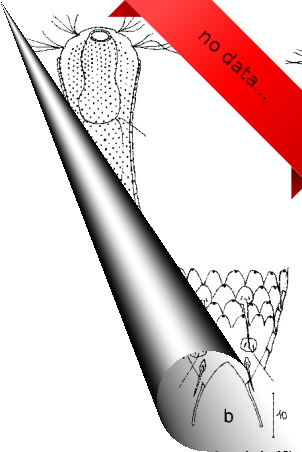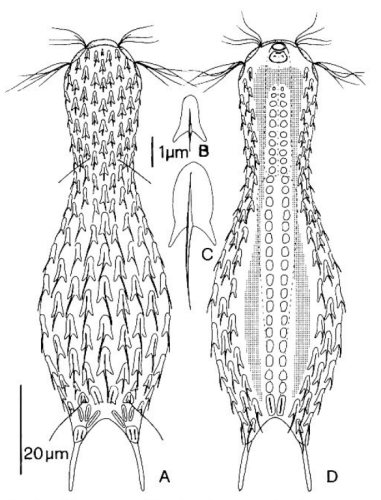(Hystricochaetonotus)

- Body length 60 - 190 µm
- three-lobed scales with axial keel
- spine with secondary tip (but can sometimes be absent or double)
- all scales spiny, spines elongate from front to back
For the subgenus Hystricochaetonotus are the relatively large, non-overlapping scales with a long spine. This subgenus owes its name to this spiny appearance (hystix = porcupine).
 *Typical Chaetonotus (Hystricochaetonotus) - here
C. (H. ) persetosus
*Typical Chaetonotus (Hystricochaetonotus) - here
C. (H. ) persetosus
The scales are in typical arrangement. Their shape is trilobate with a central keel, at the end of which arises a long spine - usually with a secondary tip:

typical three-lobed scales in Hystricochaetonotus - here
C. (H. ) persetosus
46 Species:

Chaetonotus (H. ) ferrarius

Chaetonotus (H. ) fujisanensis

Chaetonotus (H. ) gulosus

Chaetonotus (H. ) heterochaetus

Chaetonotus (H. ) hornsundi

Chaetonotus (H. ) horridus

Chaetonotus (H. ) hystrix

Chaetonotus (H. ) inaequabilis

Chaetonotus (H. ) iratus

Chaetonotus (H. ) italicus
91 µm - 110 µmDorsal scales: 13 rows of 13-14 three-lobed scales (6.5µm x 5µm) with simple spine (3µm - 10µm); typical scale group for Hystricochaetonotus without spines at the posterior end
Ventral scales: ventral intermediate field with two rows of 20 rectangular scales each (1.2µm - 4µm); two keeled terminal plates (length 6.4µm - 6.8µm)
Particularities: Spines without secondary tip; unique scaling of the ventral intermediate field